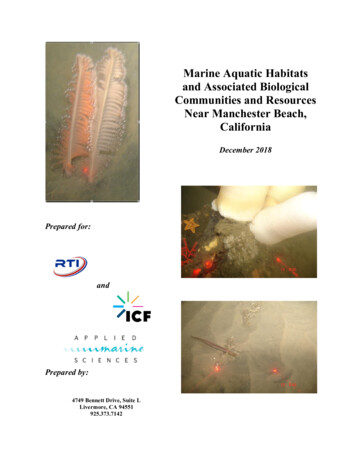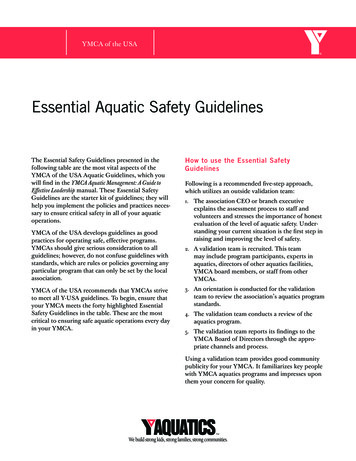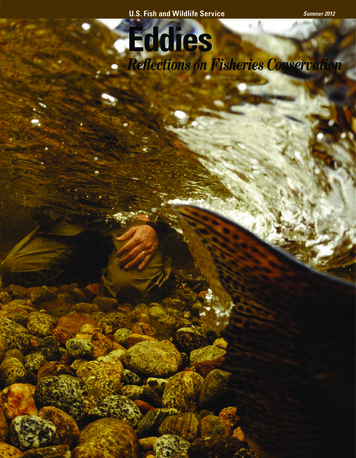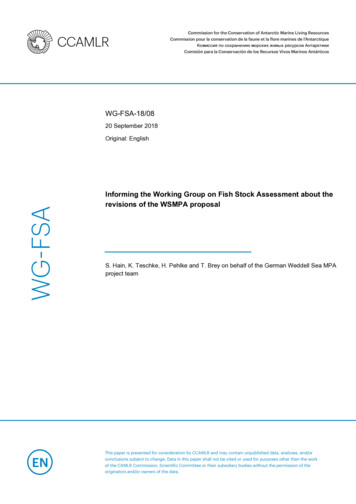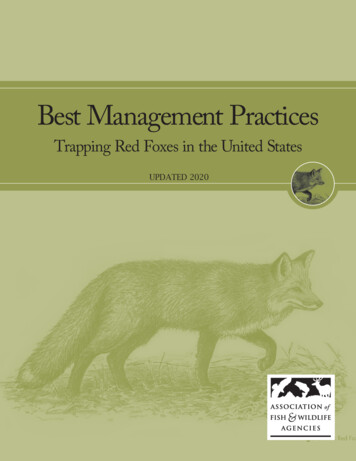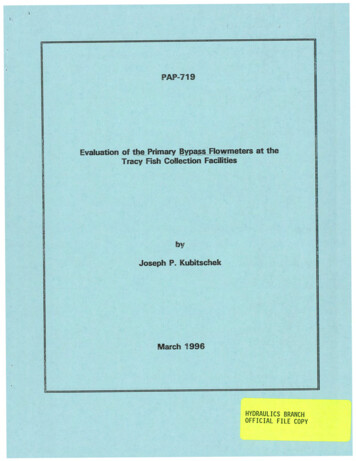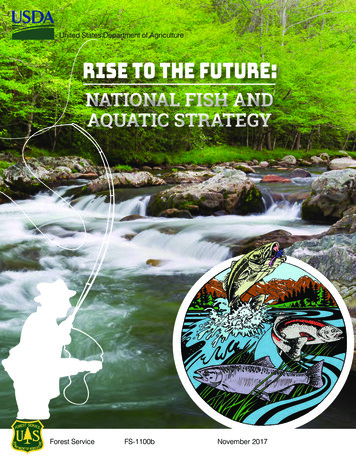
Transcription
United States Department of AgricultureRISE TO THE FUTURE:NATIONAL FISH ANDAQUATIC STRATEGYForest ServiceFS-1100bNovember 2017
Contents82I. Introduction5Challenges andOpportunties6Overview of Strategy andHigh-Priority Actions7II. Strategic Goals8GOAL 1: Conserve Fishand Aquatic Resources12 GOAL 2: Connect Peopleto the Outdoors ThroughFishing, Boating, andOther Aquatic Activities14 GOAL 3: StrengthenPartnerships and WorkAcross Boundaries1417 GOAL 4: Deliver andApply Scientific Research19 GOAL 5: Build CapacityThrough Mentoring andTraining22 GOAL 6: Communicatethe Value and Benefitsof Fish and AquaticResources24 III. Measuring Progress25 Appendix A. Contributors27 Appendix B. Alignmentof Rise to the Future:National Fish and Aquatic22
The Forest Service hasan important role instewardship of exceptionalfish and aquatic resourcesfor the benefit of theAmerican people.Message From the ChiefWhen people think of the national forestsand grasslands, they often think ofspectacular scenery, including wild riversand mountain lakes. They might remember seeinga deer, hearing an owl, or catching a fish in a clearmountain stream. Such memories can last a lifetime,and they are integral to what the national forests andgrasslands mean to the American people.President Theodore Roosevelt and other visionarieswho founded the National Forest System did so,in part, to conserve America’s heritage of fish andaquatic resources. Since the beginning, the ForestService has found that conserving healthy fishhabitat and restoring aquatic resources is centralto its mission to sustain the health, diversity, andproductivity of the Nation’s forests and grasslands tomeet the needs of present and future generations.healthy habitats for fish and other aquatic species.The national forests and grasslands include someof the Nation’s best remaining habitats for manythreatened and endangered fish species. Such habitatsare vital for sustaining fish populations important forcommercial, recreational, and subsistence uses.This strategy will guide the Forest Service to workwith our partners to sustain these valuable resources.Our work to protect, restore, and enhance naturalresources has become increasingly integrated acrossForest Service mission areas and disciplines and evermore collaborative. As we carry out this strategy, wewill ensure that abundant fish and aquatic resourcesand healthy aquatic habitats are available forAmericans to enjoy both now and for generations tocome.Healthy streams, lakes, and rivers benefit Americansin a myriad of ways, from clean drinking waterto diverse recreational opportunities. One in fiveAmericans relies on water that comes from NationalForest System lands. Abundant clean water that giveslife to human communities is clearly connected toRise to the Future: National Fish and Aquatic Strategy–TONY TOOKEChief1
I.IntroductionForest Service Motto:Caring for the Land and Serving PeopleImage Freshwaters IllustratedFounded more than 100 years ago, the ForestService, an agency of the U.S. Departmentof Agriculture (USDA), plays a key role in thestewardship of fish and aquatic resources. Theagency oversees protection, management, use, andstewardship of natural and cultural resources on154 national forests and 20 national grasslands,containing more than 193 million acres from NewEngland to Florida and Alaska to California. TheForest Service has a unique role to foster healthywatersheds and aquatic habitats that sustainabundant, uniquely adapted fish and wildlifepopulations for the ecological, social, and economicneeds of the American people. In order to do this,the agency relies upon and cooperates closely withmany branches of State governments, especially fishand wildlife agencies, and other Federal agencies andtribal governments; each having their own uniqueauthorities and roles. The Forest Service also partnerswith many nongovernmental organizations, privatelandowners and water users, the private sector,and others to fulfill its role in stewarding fish andaquatic resources on national forests and grasslands.These lands, making up the National Forest System,Rise to the Future: National Fish and Aquatic Strategy2
contain some of the Nation’s healthiest intact aquaticecosystems that contribute to sustaining the Nation’sfish and aquatic resources. The agency’s work instewarding fish and aquatic resources is integratedacross its three primary mission areas: NationalForest System, Research and Development, and Stateand Private Forestry. These primary mission areasand many of the program areas within each missionarea are involved in achieving fish and aquaticstewardship at all levels of the agency. Across allaspects of the agency, the Forest Service improvesthe lives of people in local communities, rural andurban, by conducting cutting-edge research on fishand aquatic ecology and working collaboratively toimprove the condition of fish and aquatic resourcesfor the benefit of the American people.The Forest Service, working in collaborationwith many others and seeking input from a broadconstituency, has updated its Rise to the FutureFisheries Strategy herein as the Rise to the Future:National Fish and Aquatic Strategy. A team ofnearly 60 participants across the agency and withrepresentatives from the American Fisheries Society,American Sportfishing Association, Association ofFish and Wildlife Agencies, National Fish HabitatPartnership, National Fish and Wildlife Foundation,Recreational Boating and Fishing Foundation, TheNature Conservancy, The Wilderness Society, andTrout Unlimited developed this update (see appendixA). This strategy builds on three decades of successand lessons learned from the original Rise to theFuture Fisheries Strategy developed in 1987. Theupdated strategy was called for by cooperators andpartners. The upated strategy is needed to integrateForest Service programs and actions related to fishand aquatic stewardship in all parts of the agency,particularly through watershed-scale restorationand partnerships. Additonally, it better aligns withand complements the agnecy’s strategic plan (seeAppendix B). The updated strategy is more relevantto the agency’s cooperators and partners, underscoresand recommits the agency to promoting recreationalfishing and outdoor aquatic activities, and betteraddresses the economic value and benefits of fish andaquatic resources to the public.Fish and aquatic species areamong the most endangeredgroups of organisms in theUnited States. National forestsand grasslands provide morethan half of the habitat forfederally protected freshwaterfishes, mollusks, andamphibians.More than 220,000 milesof rivers and streams andmore than 10 million acresof lakes, reservoirs, andponds on national forests andgrasslands provide a widerange of fishing opportunitiesfor the American people.Rise to the Future: National Fish and Aquatic Strategy3
FO R EST SE RVICEnoissiMThe Forest Service is guided by a principle ofsustainable multiple use and has an eloquentand progressive mission: To sustain the health,diversity, and productivity of the Nation’s forestsand grasslands to meet the needs of present andfuture generations.istockphoto.comRise to the Future: National Fish and Aquatic Strategy4
Challenges andOpportunitiesThe Nation’s forests and grasslands are undergoingvast ecological and socioeconomic change, partly dueto a confluence of stressors, including large wildfires;outbreaks of insects and disease; invasive species;land use changes; and increased drought, flooding,and water temperatures. However, many aquatichabitats on national forests and grasslands are ofhigh quality despite legacy impacts from historicalmining, timber harvesting, grazing, and development.Demand is growing for the many aquatic resourcesand services that people get from watersheds onnational forests and grasslands, including waterthat is clean, abundant, and cold enough to supporthabitat for aquatic species. As the country changesand grows, the Forest Service and its cooperatorsand partners will continue to sustain and restorefish and wildlife habitat, recreational infrastructure,and healthy watersheds by using the best availablescience to integrate stewardship of fish and aquaticresources into land management. Restoring watershedhealth and function is critical to sustaining theclean and reliable water supplies and the fish andaquatic resources that communities value, use, andappreciate.The Forest Service is working to increase thepace of restoration to meet its stewardship mandatewhile creating more jobs on the national forestsand grasslands. To do so, the agency is investing inpartnerships and bringing people together to achieveshared objectives. Partners contribute millions ofdollars and tens of thousands of volunteer hoursannually to ecosystem restoration projects on andoff National Forest System lands. A renewed,collaborative focus on restoring habitat, fishpopulations, water quality, and natural processeshelps to improve aging infrastructure and feeds bothrecreation and restoration economies, particularly inrural communities.Millions of people fish on nationalforests and grasslands, providingmore than 2.2 billion of economicactivity each year. National forestsin Alaska support a world-renowned,billion-dollar commercial salmonindustry, as well as culturallyimportant subsistence fisheries forAlaska Native communities.Rise to the Future: National Fish and Aquatic Strategy5
OVerview of strategy andhigh-priority actionsThis strategy contains six goals:1. Conserve fish and aquatic resources.2. Connect people to the outdoors through fishing,boating, and other aquatic activities.3. Strengthen partnerships and work acrossboundaries.4. Deliver and apply scientific research.5. Build capacity through mentoring and training.6. Communicate the value and benefits of fish andaquatic resources.Each goal contains multiple objectives, providinga long-term foundation to address current and futurechallenges, including invasive species; impacts fromdrought, floods, and other extreme weather events;increasing public demands; and limited resources.The goals and objectives contained in this strategywill better enable the Forest Service to take advantageof new opportunities such as emerging researchtechnologies and innovative and nontraditionalpartnerships.Eight specific actions are highlighted as near-termpriorities to strategically focus implementation of thestrategy with current resources. The Forest Servicewill work in cooperation with States, especially Statefish and wildlife agencies, other Federal agencies,and tribal governments and in partnership withnongovernmental organizations, private landownersand water users, the private sector, and others toimplement these near-term priorities. Each action isassociated with a clear deliverable or quantifiableaccomplishment and an associated timeframe.Realizing the actions in coordination with cooperatorsand partners will demonstrate the strategy isproducing intended results.1. Increase the number of youth and adultsconnecting to the outdoors through recreationalfishing and other aquatic activities by 50percent, from fiscal year 2017 levels, by 2023.2. Increase partnerships with States, other Federalagencies, tribal governments, water providers,corporations, and multistakeholder groupsthat result in meaningful fish and aquaticstewardship outcomes with multiple benefitsby 20 percent, from fiscal year 2017 levels, by2023.3. Identify barriers to increasing recreationalfishing participation and identify high-priorityactions that will yield the greatest increase inparticipation by 2019.4. Develop a coarse-scale national assessment ofaquatic biodiversity by 2019.5. Develop criteria for identifying conservationwatersheds for fish and aquatic specieson national forests and grasslands. Selectconservation watersheds by 2020. Update thelist as needed. [See goal 1 for a description ofconservation watersheds.]6. Conduct and distribute a national fish andaquatic ecology research needs assessment by2019.7. Develop business practices and protocols foreffective mentoring of fisheries biologists andaquatic ecologists by 2018.8. Work with experts to develop and implement acommunications and outreach plan by 2018.Rise to the Future: National Fish and Aquatic Strategy6
II.STRATEGICGOALSThe Forest Service is committed to working agency–wide in an integrated manner to accomplish all sixgoals in this strategy. More importantly, the ForestService cannot do it alone and is strongly committedto working in cooperation with States, especially Statefish and wildlife agencies, other Federal agencies,and tribal governments and in partnership withnongovernmental organizations, private landownersand water users, the private sector, and others toaccomplish specific objectives and tasks identified inthe six goals of this strategy. The practice of workingin cooperation and in partnership with others isimplicit throughout objectives and tasks identifiedunder each of the six goals; however, in someinstances additional emphasis is added.Credit: USDA Forest Service, Alan DyckRise to the Future: National Fish and Aquatic Strategy7
Healthy watersheds and clean water on national forests and grasslands improveopportunities for people to explore and enjoy the aquatic world.Credit: Image Freshwaters IllustratedGOAL 1:Conserve Fish andAquatic ResourcesSustaining healthy watersheds and aquatic ecosystems that supportan abundance and diversity of fish, other aquatic species, and theirhabitats is part of the Forest Service’s mission. To achieve its mission,the Forest Service protects, restores, and enhances watersheds and aquaticecosystems upon which populations of fish and other aquatic species depend.The agency’s strategies and actions are designed to help aquatic species andecosystems adapt to multiple stressors, including drought, floods, increasingwater temperatures, changes in precipitation patterns, invasive species, fire,and disease.Rise to the Future: National Fish and Aquatic Strategy8
To conserve fish and aquatic resources, the ForestService will identify watersheds important for thestewardship of fish and other aquatic species. These“conservation watersheds” will help managersstrategically plan and prioritize activities for thegreatest ecological, social, and economic benefits.Conservation watersheds are intended to help identifyand sustain both common and rare species andhabitats as well as natural processes at multiple scales(forestwide, regionwide, and nationwide), helpingbuild a network of healthy, functioning watershedsacross the landscape. Conservation watersheds willrepresent a strategic, long-term approach to workingwith cooperators and partners to improve aquaticconditions.Conservation watersheds will complement, notreplace or take away from Priority Watershedsidentified through the agency’s 2011 WatershedCondition Framework. Through the WatershedCondition Framework, the Forest Service assessedand classified watershed conditions in more than15,000 6th field subwatersheds (HUC12) on NationalForest System lands and works with cooperatorsand partners to protect and maintain functioningwatersheds and to restore degraded watersheds.By definition, high-priority watersheds under theWatershed Condition Framework are designated assuch for relatively short periods of time, generally 3to 5 years. In contrast, identification of conservationwatersheds is intended to help protect and maintainthe most intact aquatic systems as well as restoredegraded watersheds of high importance forstewardship of fish and aquatic resources over thelong term. There will likely be some overlap amongconservation watersheds and Watershed ConditionFramework high-priority watersheds.In cooperation with States, other Federal agencies,and tribal governments, the agency will monitorthe populations of fish and other aquatic species,along with their habitats. Knowledge gained frommonitoring will help the agency better understand thecomplex and ever-changing ecosystems it manages,as well as evaluate approaches and formulate newstrategies for sustaining and restoring them.LONG-TERM VISIONWatersheds and aquatic ecosystems across thenational forests and grasslands are in a healthycondition characterized by complex, interconnected,and diverse habitats. They contain self-sustainingassemblages of fish and aquatic species and havea high level of resilience in the face of multiplestressors, including natural disturbances.OBJECTIVESObjective A: Evaluate the current statusand diversity of fish and other aquatic species andtheir habitats on National Forest System lands incooperation with States, other Federal agencies,and tribal governments and in partnership withnongovernmental organizations and others.i.Develop a coarse-scale national assessment ofaquatic biodiversity and associated visualizationtools by 2019, including identification ofimportant fish and other aquatic species, theirconservation status and trends, public use, andcritical information gaps using available dataand assessments from State fish and wildlifeagencies, tribal governments, other Federalagencies, and nongovernmental organizations.Update the assessment every 10 years.ii. Encourage development and updates of regionalassessments of aquatic ecosystems on thenational forests and grasslands that tier to thenational assessment and contribute to forestplan revision and subsequent monitoring. Createor update regional geospatial fish and aquaticspecies distribution maps, including migrationbarriers, and enter Forest Service aquatic surveydata into appropriate corporate databases forlong-term data stewardship and sharing withother agencies and interested partners.iii. Encourage development and updates of finerscale assessments of aquatic ecosystems onthe national forests and grasslands that tier toregional assessments and contribute to forestplan revision and subsequent monitoring.Rise to the Future: National Fish and Aquatic Strategy9
Objective B: Identify conservation watershedsto help the Forest Service strategically focus onprotecting, restoring, and enhancing fish and otheraquatic species.Objective D: Carry out strategic protection,restoration, and enhancement actions and demonstratebeneficial outcomes for fish and aquatic communities.Perform watershed- and site-specific protection,restoration, and enhancement activities basedon watershed and threat assessments. Whereappropriate, emphasize postfire watershedrestoration and water quality best managementpractice (BMP) implementation and monitoring.Work in an integrated, interdisciplinary mannerin collaboration with partners.ii. Plan and carry out road-related restorationactivities, including BMP implementationand monitoring, to reduce risks and damageto aquatic resources, protect transportationinfrastructure, and ensure safe access forcommunities.iii. Work with the ranching and irrigationcommunities and encourage new partnershipsfor working-lands solutions on National ForestSystem lands to improve riparian and aquatichabitats.iv. Limit and reduce the impacts of invasive specieson the Nation’s fish and aquatic resourcesby implementing best practices, includingdecontamination of boats and gear, and supportpublic outreach and education to prevent thespread of invasive species. Work closely incooperation with States, other Federal agencies,and tribal governments and in partnership withnongovernmental organizations to prevent theintroduction and spread of invasive species.Participate in multipartner monitoring andsurveillance programs to detect new invasionsand to rapidly respond.v. Track restoration actions and associatedperformance outcomes using official databases,including updating and tracking of watershedrestoration actions plans as part of the agency’sWatershed Condition Framework.i.i.Cooperate with States, other Federal agencies,and tribal governments and partner withnongovernmental organizations and others todevelop criteria
recreation and restoration economies, particularly in rural communities. Millions of people fish on national . forests and grasslands, providing more than 2.2 billion of economic activity each year. National forests . in Alaska support a world-renowned, billion-dollar commercial salmon

